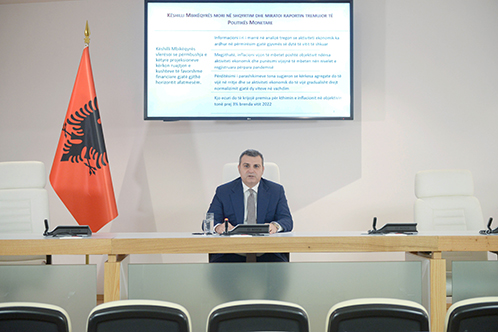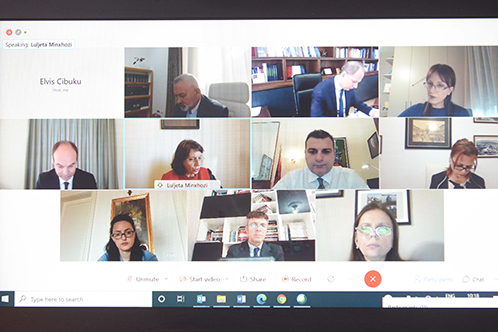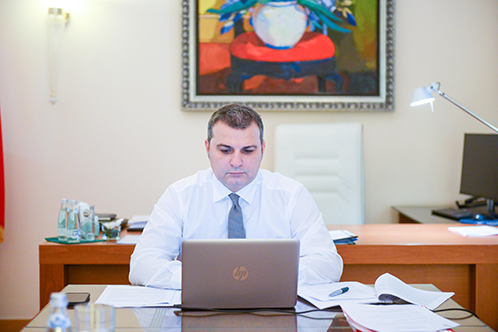BANK OF ALBANIA
PRESS RELEASE
Governor Sejko: Statement to the Press Conference on Monetary Policy Decision, 3 February 2021
Publication date: 03.02.2021
Dear media representatives,
Today, on 3 February 2021, the Supervisory Council of the Bank of Albania reviewed and approved the Quarterly Monetary Policy Report.
The new information analysed in this Report shows that economic activity have been improving during the second half of last year. The Supervisory Council deems this improvement was faster than the expectations of the Bank of Albania. Though, it notes that inflation continues to undershooting the target, while economic activity and employment continue to remain below pre-pandemic levels.

Our updated projections suggest that aggregate demand will trend upwards and economic activity will gradually normalise during the next two years. This normalisation, in turn, will enable an increase in employment, wages and profit margins of enterprises, hence creating premises for inflation to converge to its 3% target within 2022.
The Supervisory Council assesses that the realisation of these projections requires maintaining the favourable financing conditions throughout the medium-term horizon. In this view, the Supervisory Council considers that the current monetary policy stance remains adequate.
***
Economic activity in Albania showed recovery trends in the second half of 2020, after the deep recession recorded in the second quarter. Nevertheless, the negative impact from the pandemic continues to be present, on both macroeconomic indicators and on enterprises and households financial soundness indicators.

Inflation registered 1.6% on average in the fourth quarter, slightly upwards from the previous quarter. Its fluctuations mainly reflected the volatilities in prices of food items. On the other side, core inflation - which reflects more clearly the medium-term trends of prices increase - continued to be stable, but below the rates targeted by the Bank of Albania. This performance shows the fading out of supply-side shocks in the second half of year, and the weak pressures generated from the aggregate demand.
According to INSTAT data, the economic activity recorded and annual fall of 3.5% in the third quarter, considerably improving, in relative terms, when compared to the depth of recession recorded in the second quarter. This improvement reflected the opening of the economy, growth of investments, and a slower drop in both private consumption and exports. The expansion of aggregate demand was reflected in the increase of the activity in construction sector, and a lower contraction in the sectors of industry and services.
The improvement of the economic activity was also reflected in employment indicators. Employment increased by around 34 000 persons during the third quarter, recovering around 2/3 of losses recorded in the previous quarter. The unemployment rate fell to 11.6%.

The available data on economic activity for the fourth quarter are indirect and still incomplete. However, the Bank of Albania assesses that economic activity in Albania has continued to recover further, notwithstanding the difficulties caused by pandemic and the unfavourable external environment.
Apart from the easing of containment measures taken to control the pandemic spread, the recovery was fuelled by the fiscal stimulus transmitted throughout 2020 and the simulating financial and monetary policies implemented by the Bank of Albania.
The budget deficit accounted for around 5.1% of GDP in the first 11 months of year. This deficit reflected both the fall in income during the calendar year, and the increase in current and capital expenditures during the year.
According to our estimates, the simulating monetary policy and the temporary easing of regulations on the functioning of banking system implemented by the Bank of Albania, enabled the smooth functioning of financial markets and established an adequate environment for sustaining lending last year.
Financial markets have continued to function normally during the fourth quarter as well. The exchange rate was stable; the interest rates remain close to their historical minimums, while lending continued to grow further. In particular, credit to private sector recorded an annual growth of 7.7% during 2020, thus helping both the Albanian households and enterprises to fulfil their needs for liquidity and providing the needed financial means for increasing consumption and investments.
The Bank of Albania judges that banking sector has helped to mitigating the consequences of pandemic hit. This sector undertook a part of the financial burden of the shock, and simultaneously maintaining sound indicators of liquidity, profitability and capitalisation. The non-performing loans ratio, in particular, dropped to 8.1%, at the end of December. This level is close to the historical minimums of the last decade. The continuation of this active role by the banking system during the next period will be crucial for the sustainable economic recovery.
Our baseline scenario of the expected developments assumes a gradual alleviation of measures taken to contain the pandemic and the progressive reduction of its consequences. In this scenario, the Albanian economy is expected to record relatively fast and stable growth rates in the next two years. Inflation is expected to stay close to the current rates in the present year. Further ahead, the return of economic activity close to the potential will provide the conditions for inflation to converge to target within 2022.
***
The Supervisory Council assesses that the economic normalisation should continue to be supported by maintaining a simulating profile of economic policies. In addition, it finds that the balance of risks remains on the down side. In particular, downside risks arise from:
- a possible worsening epidemiological situation in Albania and globally;
- problems arising in the monetary policy transmission mechanism, in the form of: increased interest rates and financing costs to the private sector; slower credit supply growth; and
- a slower reaction by enterprises and households towards the improved financial conditions.
In conclusion to its discussions, the Supervisory Council assesses that the monetary policy stance remains adequate for increasing economic growth and for the sustainable return of inflation towards the 3% target.
In this view, the Supervisory Council decided to:
- Keep the policy rate unchanged, at 0.5%;
- Keep the overnight deposit and overnight lending rates, unchanged at 0.1% and 0.9%, respectively.
The Supervisory Council highlights that monetary policy stance will continue to remain accommodative throughout the medium-term horizon, in order to provide favourable financing conditions supportive of economic growth and for the return of inflation to target. In addition, the monetary stimulus will benefit from maintaining the current form of unlimited liquidity injections at fixed price to the banking sector, at least through the second quarter of this year.
Last, the Supervisory Council assesses that the materialization of these risks would require further easing of monetary policy stance.

 Twitter
Twitter
 Youtube
Youtube
 Facebook
Facebook
 Flickr
Flickr
 RSS
RSS
 Subscribe
Subscribe
 Feedback
Feedback